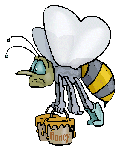CHESHIRE BEEKEEPERS' ASSOCIATION
Apes curamus et nos curant (We look after bees and they look after us)
Founded 1899
Registered Charity No. 227494

Bee Facts
Within the bee colony there are 3 castes a) One Queen b) Thousands of Workers c) Several Hundred Drones.
The Queen is the mother of the bees and lays the eggs. The workers are under developed females that do all the work, and possess the sting. The drones, or males who mate with the virgin Queens to produce new colonies. Drones have no sting.
Honey bee colonies can have upward of 60,000 bees compared with Bumblebee nests which will only have say 150 bees.
Honey bees are the vegetarians of the insect world. They collect nectar (carbohydrate or energy), which is converted into honey, and pollen (protein).
Beeswax is secreted from special glands on the bee�s abdomen and the bees will hang on to each other and build comb within any enclosed space they occupy. Each of the cells in the comb is 6 sided, or hexagonal making the most efficient use of space and the hexagonal structure is so strong that 25g in a standard frame can support up to 2300 g of honey. Comb is used for rearing the brood and for storing pollen and honey.
The Queen lays the eggs in the cells and the time from egg to emerging insect depends on which caste is being produced.
Egg to Queen is 15 days, Egg to Worker is 21 days, Egg to Drone is 24 days.
The life of a worker bee is short; 6 weeks in the Summer (3 in the hive, 3 on the wing), but September hatching bees can live until March/April. In general it is bring up the brood and foraging and hive duties which wears out a bee.
Bumblebee and wasp colonies die out each year with fresh queens produced each year. It is the new queens which hibernate and produce the colonies the following year.
Honey bee colonies survive over the winter and start up in the Spring with the Queen and Workers they went into the winter with.
Honey bees have 6 legs, 4 wings. For sight they have 2 compound eyes comprising a number of lenses (Queen 5000, Worker 6900, Drone 8600) and 3 simple eyes on the top of the head.
Touch, taste, feel and smell are all present usually more acute than man�s. As far as we know they cannot hear but can sense vibrations.
The range of vision is different to man�s. Human vision extends across the colour spectrum from wavelengths of 0.4 �m to 0.76 �m which roughly corresponds violet/blue to red.
The bee�s spectrum of colour is from 0.3 �m to 0.65 �m corresponding from ultraviolet to yellow. From this it can be seen that bees cannot detect red but some red flowers reflect ultraviolet light which the bee can see.

